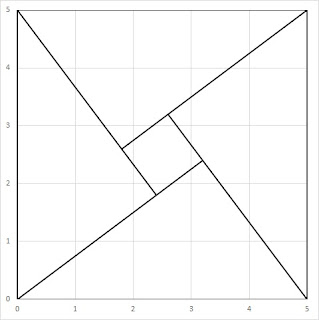The Riddler Cheese Company is producing what are called “craft triples” — triangular slices of cheese whose side lengths are Pythagorean triples, when measured in inches.
However, the company’s slicing machine recently malfunctioned and produced a stock of square slices with side lengths of 5 inches. To salvage this situation, what is the greatest number of whole Pythagorean slices that can be made from each 5-inch square? (Note: You can only cut pieces out of the square. No melting or gluing pieces together!)
Since every other Pythagorean triple would be too large for a $5 \times 5$ square, we have to figure out how many $3-4-5$ triangles can fit into it. Since the hypotenuse of a $3-4-5$ triangle is, well, $5$ inches long, we can fit four triangles in with the hypotenuse along each side of the square.
Extra credit: What is the smallest square of cheese such that 100 percent of the square can be partitioned into craft triples?
The smallest Pythagorean triple is $3-4-5$, which has an area of $6$ square inches. We would need to have an $N \times N$ square where $6 \mid N^2$ in order to be able to completely tile it with $3-4-5$ triangles. If we have $N = 12$, then we can tile the $12 \times 12$ square with $4$ rows of three $3 \times 4$ rectangles each. These rectangles can then be broken down into two $3-4-5$ triangles apiece. The only other possible smaller value of $N$ would be $6,$ in which case there would need to be six $3-4-5$ triangles. However, since $3 + 4 > 6$ there is no way to jam more than two triangles next to one another in both dimensions of the $6 \times 6$ square, thus we cannot completely fill up the square.
Note that by the time you get to the $12 \times 12$ triangle, you don't have to rely on $3-4-5$ triangles, as you can also throw in some of the next largest $5-12-13$ Pythagorean triples.



No comments:
Post a Comment